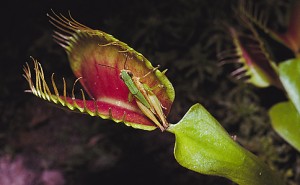The Meat-eating (and Counting!) Plant
February 5, 2016.
As if it weren’t terrifying enough, scientists have now discovered that Venus’s-flytrap, a plant, is intelligent enough to count! A team of German scientists led by Rainer Hedrich of the University of Wurzburg studied the carnivorous (meat-eating) plant and found they have a simple ability to distinguish numerical information. The researchers believe this skill enables the predatory plant to avoid wasting valuable energy on false captures. The team reported their findings this week in the journal Current Biology.
Venus’s-flytrap (Dionaea muscipula) is the most well-known of several plants that have special adaptations to trap insects and digest them for essential nutrients. They are found in the coastal regions of North and South Carolina. They grow in bogs where the soil has little nitrogen or phosphorus, essential nutrients that help provide energy for the plant to grow and reproduce. Venus’s-flytrap has specially modified leaves made up of two hinged lobes. The surface of each lobe is covered with sensitive hairs. When an insect touches these hairs, the two lobes snap shut. Special glands of the leaf produce a digestive fluid. The fluid digests the soft parts of the insect. After the plant has taken in the digested insect, the trap opens. The leaf is in position to capture another victim.
Hedrich and his team conducted experiments where they tapped the sensitive trap hairs on the Venus’s-flytrap leaves with a metal probe. They then recorded the reaction of the plant. They found that a single touch of a metal probe to a trap hair would not trigger the leaf to snap shut, but would put the plant into a “ready” mode, primed for action. The leaf would only snap shut if a second trap hair was touched. The plant would begin secreting fluids to digest its prey only after the trap hairs had been touched at least five times.
The researchers believe the plant’s simple ability to distinguish the number of times a trap hair is triggered is an important adaptation to an environment where vital energy from food is scarce. Venus’s-flytrap‘s vice-like leaves will not close unless triggered more than once to guarantee that a prey insect has actually landed, instead of some other object, like a raindrop. As more trap hairs are triggered, the plant is informed that a struggling prey has indeed been captured. Only then will the plant begin secreting digestive fluids. This crude mathematical skill allows Venus’s-flytrap to conserve scarce energy and avoid false alarms when feeding.



